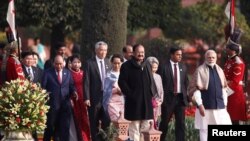Four years ago, India hosted the leaders of the Association of Southeast Asian Nations (ASEAN) at its annual Republic Day Parade — a symbolic gesture by New Delhi to give momentum to its partnerships with the10-member grouping.
That effort is gathering pace as India and other countries like the United States seek to push back against China’s growing clout in the Indo Pacific region.
Starting Thursday, New Delhi will hold a two-day meet of foreign ministers of ASEAN to mark the 30th anniversary of relations with the group and to discuss ways to boost cooperation — 2022 has been designated the India-ASEAN friendship year.
Speaking at a June 10 news briefing, India foreign ministry spokesman Arindam Bagchi said the ASEAN-India strategic partnership stands on a strong foundation. “The ASEAN is central to India’s Act East Policy and its vision for the wider Indo-Pacific,” he said.
The ten ASEAN countries are Singapore, Thailand, Vietnam. Brunei, Cambodia, Indonesia, Laos, Malaysia, Myanmar and the Philippines.
Although Indian and ASEAN foreign ministers meet annually, the New Delhi event has been billed as a special meeting.
It is being held three weeks after a summit of the Quad in Tokyo, where U.S. President Joe Biden launched the Indo-Pacific Economic Framework (IPEF) to increase engagement in the Asian region. Besides the Quad members — India, Japan and Australia, seven ASEAN members signed on to the treaty — Brunei, Singapore, Indonesia, Thailand, Malaysia, Philippines and Vietnam.
“Everyone is trying to woo the ASEAN, because of its centrality to the Indo-Pacific. These countries are crucial if you want to have a viable policy for this region,” said Manoj Joshi, a fellow at the Observer Research Foundation, a think tank based in New Delhi. “For India also, ASEAN is important.”
Analysts however point out that as Beijing has been the grouping’s biggest trading partner since 2009, ASEAN countries are careful to balance their ties with both sides. Trade with China, which remains a big market for their exports, touched around $ 878 billion in 2021, according to the Chinese state-controlled news website Global Times.
At the same time though, some of these countries are locked in maritime disputes with China, which has built man-made islands in waters claimed by several countries in East Asia.
“ASEAN countries are very pragmatic. They are looking to see how to gain from building ties with both sides,” said Joshi pointing out that these countries want strategic balance in the Indo-Pacific as China becomes increasingly assertive.
However, analysts say that India will need to increase economic engagement with ASEAN countries to rachet up its influence. But it remains at a disadvantage because it did not join the Regional Comprehensive Economic Pact (RCEP), the world’s largest trade pact that went into effect this January. Besides the ASEAN countries, the trade pact includes China, Japan, South Korea, Australia and New Zealand.
India backed out of the RCEP due to concerns that lower-cost imports, particularly from China, would impact its local industries.
“India has not been able to improve its exports to the ASEAN region because our manufacturing industries are not competitive,” points out Biswajit Dhar, a professor at the Centre for Economic Studies and Planning at New Delhi’s Jawaharlal Nehru University. “Their markets are open, but you need to have the capabilities to access them.”
Although there is no official confirmation, Myanmar’s foreign minister may not be present at the meeting that starts Thursday. Since the military coup in Myanmar last year, ASEAN, which has pushed for the restoration of democracy and an end to the crackdown on political leaders and activists, only allows non-political representation in high level meetings of the grouping.
The coup has been condemned by the international community.







